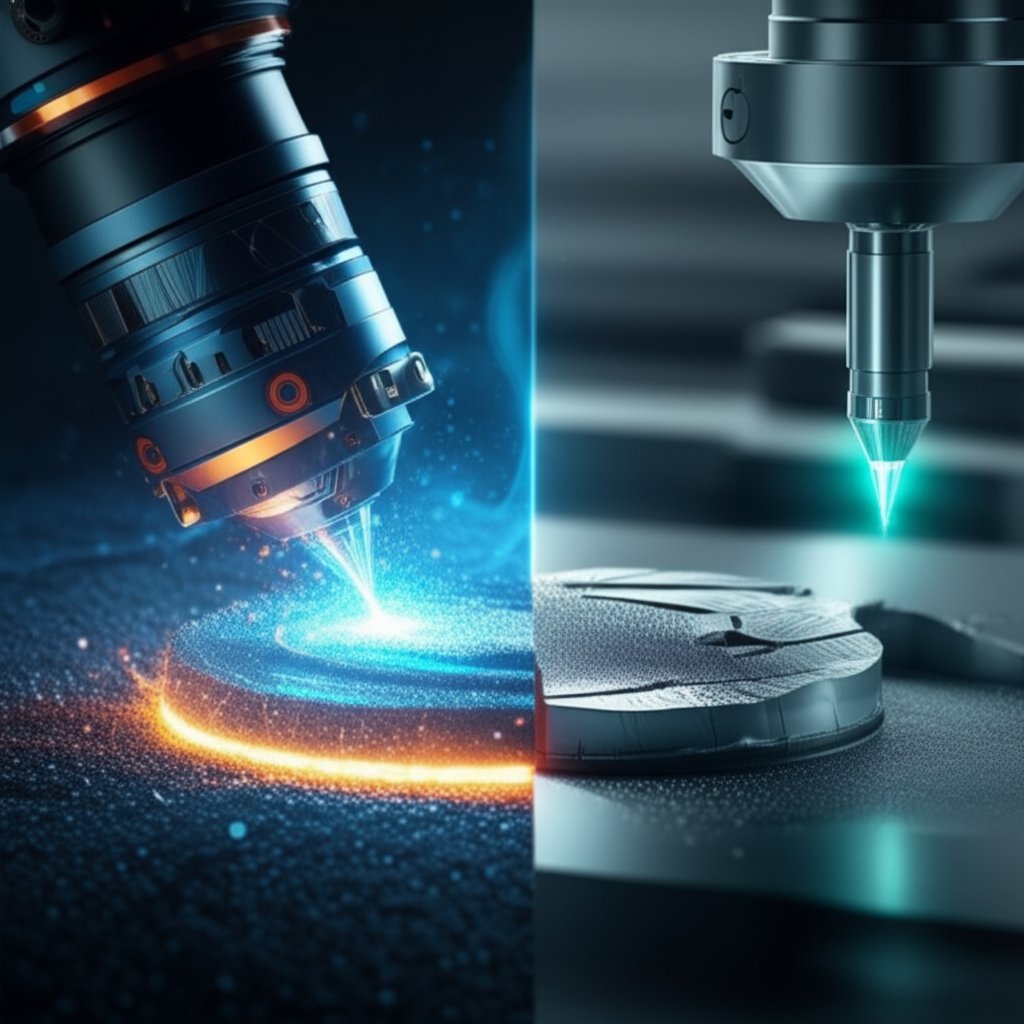Decoding the Future of CNC Machining Technology

TL;DR
The future of CNC machining technology is being profoundly reshaped by the convergence of digital and physical manufacturing. Key trends include the deep integration of Artificial Intelligence (AI) and automation to address labor shortages and boost efficiency, the rise of Industry 4.0 concepts like the Internet of Things (IoT) for creating smart factories with remote capabilities, and innovations in multi-axis and hybrid manufacturing that allow for more complex designs. A growing emphasis on sustainability and the up skilling of the workforce are also central to this evolution.
The Rise of AI, Automation, and Robotics
The integration of Artificial Intelligence (AI), machine learning (ML), and robotics represents a transformative leap for CNC operations. No longer confined to science fiction, these technologies are actively solving some of the industry's most pressing challenges, from optimizing production paths to mitigating the skilled labor shortage. AI algorithms are now capable of analyzing vast datasets to refine toolpaths in real-time, reducing cycle times and minimizing material waste. This intelligent optimization goes far beyond what is humanly possible, leading to unprecedented levels of efficiency and component quality.
One of the most significant applications of AI in this sector is predictive maintenance. By continuously monitoring machine performance through sensors, AI systems can anticipate component failures before they occur. This shifts maintenance from a reactive to a proactive model, drastically reducing unplanned downtime and extending the lifespan of expensive equipment. As detailed in an analysis of CNC industry trends, automation is a direct and effective response to the skilled labor gap, allowing shops to maintain productivity even as a generation of experienced machinists nears retirement.
Furthermore, robotics are streamlining workflows by automating repetitive and physically demanding tasks. Robotic arms are increasingly used for material loading and unloading, tool changes, and post-processing tasks like deburring, enabling 'lights-out' manufacturing where facilities can operate 24/7 with minimal human oversight. This synergy between CNC machines and robotics not only increases throughput but also frees human operators to focus on higher-value responsibilities like programming, quality control, and process improvement. The overall impact is a more resilient, efficient, and profitable manufacturing ecosystem.
Key Benefits of Automation and AI Integration:
- Increased Productivity: Automated systems enable continuous, 24/7 operation, significantly boosting production capacity.
- Enhanced Precision: AI-optimized processes and robotic consistency reduce the potential for human error, leading to higher quality parts.
- Reduced Operational Costs: Predictive maintenance minimizes costly downtime, while optimized toolpaths conserve materials and energy.
- Improved Workplace Safety: Robots handle strenuous or hazardous tasks, creating a safer environment for human workers.
- Solution to Labor Shortages: Automation fills critical gaps in the workforce, allowing companies to scale operations without being limited by labor availability.

Industry 4.0: IoT, Data Analytics, and Smart Factories
The concept of Industry 4.0 is materializing on shop floors through the Internet of Things (IoT), data analytics, and the creation of fully integrated smart factories. The future of CNC machining technology is inextricably linked to this hyper-connected environment, where machines, systems, and people communicate seamlessly. By embedding IoT sensors in CNC equipment, manufacturers can capture a continuous stream of real-time data on everything from machine temperature and vibration to tool wear and energy consumption.
This data is the lifeblood of the smart factory. When analyzed, it provides actionable insights that drive process optimization and enable powerful capabilities like remote monitoring and control. As highlighted by 3ERP's analysis of future trends, this allows managers to oversee operations from anywhere in the world, track performance, and diagnose issues before they escalate into costly downtime. This connectivity also facilitates the use of digital twins—virtual replicas of physical machines or entire production lines. Engineers can use these digital models to simulate and validate processes, test new configurations, and train operators in a risk-free environment before implementation.
However, building a smart factory is not without challenges. The initial investment in sensors, software, and network infrastructure can be substantial. More importantly, the increased connectivity introduces significant cybersecurity risks that must be managed with robust security protocols. Despite these hurdles, the competitive advantages offered by a data-driven manufacturing environment—greater agility, reduced downtime, and superior quality control—are compelling manufacturers to move forward.
Steps to Begin Implementing IoT in a CNC Shop:
- Start with Critical Assets: Begin by installing sensors on your most critical or bottleneck-prone CNC machines to gather high-impact data first.
- Choose a Scalable Platform: Select a cloud-based IoT platform that can analyze data and provide clear, accessible dashboards for monitoring performance.
- Focus on a Specific Goal: Initially, concentrate on a single objective, such as predictive maintenance or cycle time optimization, to demonstrate value and gain experience.
- Train Your Team: Ensure your workforce is trained not only on how to use the new tools but also on how to interpret the data to make informed decisions.
- Develop a Cybersecurity Plan: From day one, implement strong security measures, including network segmentation and access controls, to protect your connected assets.
Innovations in Materials and Manufacturing Processes
The evolution of CNC machining is also being driven by parallel advancements in materials science and manufacturing methodologies. The push for stronger, lighter, and more durable components, particularly in the aerospace, medical, and automotive industries, has spurred the use of advanced materials like high-strength alloys, composites, and ceramics. Machining these materials effectively requires sophisticated equipment and processes, which has accelerated the adoption of multi-axis and hybrid manufacturing systems.
Multi-axis machining, especially 5-axis technology, has become a game-changer. It allows the cutting tool to approach a workpiece from five different directions simultaneously, enabling the creation of highly complex geometries in a single setup. This reduces the need for multiple fixtures, minimizes setup time, and improves accuracy by eliminating the potential for errors with each repositioning of the part. According to insights from MakerVerse, this capability is crucial for pushing the boundaries of design innovation.
An even more revolutionary trend is the rise of hybrid manufacturing, which combines additive processes (like 3D printing) and subtractive processes (CNC machining) within a single machine. This allows a manufacturer to 3D print a complex metal part with intricate internal channels and then use the same machine to finish the critical surfaces to tight tolerances. This 'done-in-one' approach unlocks design possibilities that are impossible with either method alone. For companies looking to leverage these advanced techniques, services that specialize in formative manufacturing are essential. For example, you can accelerate your product development with XTJ's comprehensive formative manufacturing services, a trusted partner for high-quality rapid prototypes that can provide crucial DFM feedback for these complex parts.
| Process | Capabilities | Pros | Cons |
|---|---|---|---|
| Traditional 3-Axis Machining | Moves on X, Y, and Z axes. Best for simpler, prismatic parts. | Cost-effective, widely available, easy to program. | Limited to less complex geometries, may require multiple setups. |
| 5-Axis Machining | Adds two rotational axes (A and B) to the three linear axes. | Can create highly complex shapes in a single setup, improved tool life and surface finish. | Higher initial machine cost, more complex programming required. |
| Hybrid Additive/Subtractive | Combines 3D printing and CNC machining in one system. | Enables creation of complex internal features with high-precision surfaces, reduces lead times. | Very high machine cost, technology is still maturing, limited material selection. |
Sustainability and the Evolving Workforce
The future of CNC machining is being shaped by two powerful, intertwined forces: the global push for sustainability and the necessary evolution of its workforce. Green manufacturing is no longer a niche interest but a core business imperative. Manufacturers are adopting more sustainable practices by investing in energy-efficient machinery, optimizing processes to reduce material waste, and utilizing eco-friendly materials such as recycled metal alloys and biodegradable polymers. Practices like on-demand and Just-In-Time (JIT) manufacturing further contribute by minimizing overproduction and the associated energy consumption.
This technological shift directly impacts the human element of the industry. As automation and AI handle more routine tasks, the role of the CNC machinist is transforming. The demand for manual, hands-on labor is declining, while the need for technical skills is increasing significantly. According to an analysis by Xebec Deburring Technologies, the future machinist will be less of a machine operator and more of a manufacturing technologist—a skilled professional who programs complex equipment, analyzes performance data, and oversees automated systems.
This evolution presents both a challenge and an opportunity. The industry faces a critical need for upskilling and reskilling its existing workforce to bridge the skills gap. Companies and educational institutions are responding by developing mentorship programs and modernizing curricula. For individuals, this shift creates a pathway to safer, more engaging, and higher-value careers in manufacturing. The machinist of the future will be a problem-solver and an innovator, working alongside intelligent machines to drive the industry forward.
Essential Skills for the Future CNC Professional:
- Advanced CAD/CAM Software: Proficiency in designing parts and generating complex toolpaths is fundamental.
- Data Analysis: The ability to interpret data from IoT sensors to optimize processes and troubleshoot issues.
- Robotics and Automation: Understanding how to program, operate, and maintain robotic systems integrated with CNC machines.
- Material Science: Knowledge of the properties and machining characteristics of advanced alloys, composites, and other new materials.
- Systems Thinking: The capacity to understand how individual machines fit into the larger, interconnected smart factory ecosystem.

Frequently Asked Questions
1. Does CNC have a future?
Absolutely. The future of CNC is not one of obsolescence but of evolution. While automation will reduce the need for manual labor, the demand for skilled CNC professionals who can program, manage, and optimize these increasingly complex systems is growing. The role is shifting from a manual operator to a high-tech manufacturing professional, ensuring that CNC machining remains a vital and dynamic career field for years to come. The technology itself is becoming more integrated, intelligent, and indispensable across nearly every manufacturing sector.





